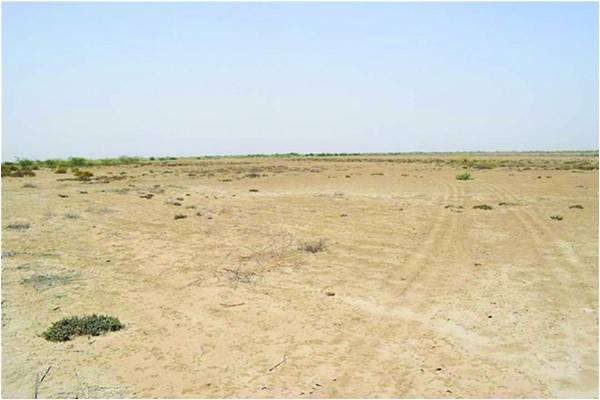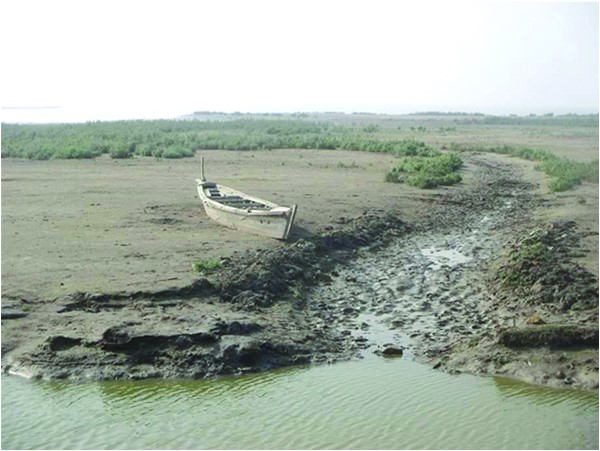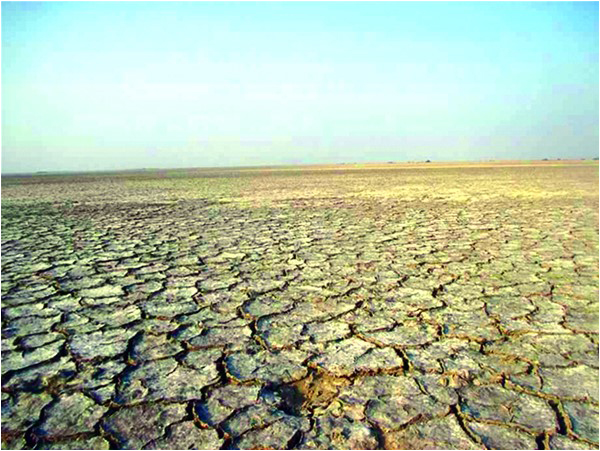
Sindh’s Larr belt, which once provided solace to the desperate soul of prominent Sindhi poet Hassan Dars as he wrote hundreds of poems on the beauty and lifestyle of locals of this region, has reached a critical point of destruction. Sea, fish, birds, villages and people – everything seems doleful here. The philosophy of life has been changed here. And such “adjustment” on the part of the people can never be considered a good development for this region – not least because of its bright past.
Hundreds of villages have been ruined here. Agricultural land once sold for some Rs. 200,000 per acre here. Today nobody is ready to buy the same land even for Rs. 2,000 per acre. There isn’t any concept of schooling or education in the entire area. The two or three unequipped as well as unstaffed health units or dispensaries are of little avail to locals.
What happened to the Larr belt? What could have transformed this prosperous and most green region of yesteryear into a valley of barren lands today?
On a cool moonlit night while having tea at the otaq of Juman Chandio in Village Ghulam Ali Chandio, I pose the question. I point my finger northwards.
“In cities the human population has reached a critical point and people have trouble finding plots to dwell in. And yet, how can it be that you people have so much empty land spread over a vast area but nobody wants to live here?”
For a second, Juman looks out over the empty landscape. Then he replies:
“What you see here is my 170 acres of agricultural land. It is unproductive since the last four years.” He smiles ruefully and continues: “Even when water for cultivation of lands was within our access in this area, I could hardly cultivate some 5 acres of this land because the rest of it has turned into an alkali flat.”
Such a revelation from Juman was not in the least shocking news for his brother and son who were sitting with us in the otaq, accustomed as they are to such a scale of environmental degradation and its impact on agriculture. But for me it was quite surprising because I had been seeing Juman as a daily-wage labourer in nearby town for a long time. I didn’t have the slightest idea that he is the owner of 170 acres of land!
“You are a landlord and yet you work as a labourer in the town?” I asked Juman.

He got off the charpoy, pointed his finger towards the west and said “Ali Wah (Canal) is positioned around 5 kilometers away from this point. It used to provide irrigation water in this entire area and tailed at the Arabian Sea through the ancient watercourses of the great Puran River. Since the last 15 months Ali Wah is waterless. All it contains is sand. If a landlord doesn’t have water to cultivate his land then how can he consider himself a landlord?”
He was continuously looking towards the west and murmuring to himself for a while.
“Though water in the canal is not available since only the last 15 months, the lands of this entire region truly died after the lethal flood of 2010.” Juman sat on the charpoy and continued:
“LBOD (Left Bank Outfall Drain) is situated around 7 kilometers away from our village. Due to that, the whole area remained underwater for months after the flood. As a result, the lands have become totally unproductive. They would remain so, even if we got water once again through the Ali Wah canal!”
Juman then pointed towards a hand pump with a broken handle that was installed beside the otaq. “This hand pump was donated by an NGO to me some years ago but unfortunately it could provide sweet water only one year. The underground water here then turned completely brackish. After that we made several attempts and made many bores on different spots of this land but failed to find sweet water. Since then it has been our daily routine to go Kadhan town which is 15 kilometers away from our village on a motorcycle and fetch a can or two of drinking water.”

Juman’s anxiousness is realistic and appropriate because he has witnessed the far more prosperous past of this region. He still remembers the trips of his ancestors to the Rann of Katchh, India. He still has in his heart the memories of those flourishing days when fish and birds could be found teeming here and the locals could proudly invite their relatives living in Karachi, Hyderabad and other districts of Sindh to visit their homes of bucolic bliss.
Gone are those days. The big villages (i.e. villages having 200+ households) of yesteryears have shrunk into 5- to 10-household villages. In some areas of this region even entire villages have disappeared altogether and dwellers of such villages have migrated to nearby cities and towns. Nobody can find a piece of green land for miles here and owing to that, only a few people of this region can maintain livestock. Most of the livestock died or people sold it due to unavailability of fodder. Electricity, health units, schools, drinking water and road facilities are still unavailable in several villages of this region.
In many villages, it seems life is still paused after two catastrophes – the 1999 cyclone and the 2010 flood. This region has little to do with the much vaunted development that the Sindh government speaks of in the province.
Before the 2010 flood, Juman was residing along with his entire family in another village which was situated around 4 kilometers away from this present location. That village consisted of 70 households but after the devastation of the flood, most of the people migrated to Kadhan and other nearby towns. But Juman with his 2 brothers and their families chose to settle here on his land.
I wanted to ask him why he didn’t move away when everyone else did. Juman himself began to explain why:
This land belongs to my ancestors so my heart didn’t permit me to sell it or go away. We brothers work as daily-wage labourers from dawn to dusk in different towns of district Badin. Though we are living in extremely harsh circumstances, we are still hopeful that one day this area will once again become prosperous.”
Juman is not the only one to still entertain such hopes.
But the facts are unforgiving. Thousands of acres of once-fertile land in Union Councils Seerani, Ahmed Rajho, Bhughra Memon, Shaheed Dodo Soomro, Mitthi 3 and Chakar Khan Panwher have become totally barren.
Shockingly, too, two complete Dehs namely Deh Bhabhrlo and Deh Loonnyathh of Taluka Badin have completely vanished into the sea but as per the district government’s revenue records both still have villages and people!
On one hand, the severe effects of climate change have made this area a wasteland. On the other, there appears to be little political will on the part of the government to remedy the situation.
On a related note, authorities such as the previous Chief Justice of the country have laid great emphasis on the need for building new dams in the country. While that in itself may be a vital priority, one wonders if anyone can explain the following: If canal water for any use is not available since the last 15 months, how can those areas receive canal water when or if big dams are constructed upstream?
Historically, this was a land of significance for the broader region. Rehamki Bazaar and Ali Bandar were the major trade hubs. Roopamarri was once the capital of Sindh. People were wealthy. Love stories flourished. Mothers of this region still remember the folklore from happier days and teach it to their children.
The writer is a freelance contributor and he can be reached at abbaskhaskheli110@gmail.com
Hundreds of villages have been ruined here. Agricultural land once sold for some Rs. 200,000 per acre here. Today nobody is ready to buy the same land even for Rs. 2,000 per acre. There isn’t any concept of schooling or education in the entire area. The two or three unequipped as well as unstaffed health units or dispensaries are of little avail to locals.
Agricultural land once sold for some Rs. 200,000 per acre here. Today nobody is ready to buy the same land even for Rs. 2,000 per acre
What happened to the Larr belt? What could have transformed this prosperous and most green region of yesteryear into a valley of barren lands today?
On a cool moonlit night while having tea at the otaq of Juman Chandio in Village Ghulam Ali Chandio, I pose the question. I point my finger northwards.
“In cities the human population has reached a critical point and people have trouble finding plots to dwell in. And yet, how can it be that you people have so much empty land spread over a vast area but nobody wants to live here?”
For a second, Juman looks out over the empty landscape. Then he replies:
“What you see here is my 170 acres of agricultural land. It is unproductive since the last four years.” He smiles ruefully and continues: “Even when water for cultivation of lands was within our access in this area, I could hardly cultivate some 5 acres of this land because the rest of it has turned into an alkali flat.”
Such a revelation from Juman was not in the least shocking news for his brother and son who were sitting with us in the otaq, accustomed as they are to such a scale of environmental degradation and its impact on agriculture. But for me it was quite surprising because I had been seeing Juman as a daily-wage labourer in nearby town for a long time. I didn’t have the slightest idea that he is the owner of 170 acres of land!
“You are a landlord and yet you work as a labourer in the town?” I asked Juman.

He got off the charpoy, pointed his finger towards the west and said “Ali Wah (Canal) is positioned around 5 kilometers away from this point. It used to provide irrigation water in this entire area and tailed at the Arabian Sea through the ancient watercourses of the great Puran River. Since the last 15 months Ali Wah is waterless. All it contains is sand. If a landlord doesn’t have water to cultivate his land then how can he consider himself a landlord?”
He was continuously looking towards the west and murmuring to himself for a while.
“Though water in the canal is not available since only the last 15 months, the lands of this entire region truly died after the lethal flood of 2010.” Juman sat on the charpoy and continued:
“LBOD (Left Bank Outfall Drain) is situated around 7 kilometers away from our village. Due to that, the whole area remained underwater for months after the flood. As a result, the lands have become totally unproductive. They would remain so, even if we got water once again through the Ali Wah canal!”
Juman then pointed towards a hand pump with a broken handle that was installed beside the otaq. “This hand pump was donated by an NGO to me some years ago but unfortunately it could provide sweet water only one year. The underground water here then turned completely brackish. After that we made several attempts and made many bores on different spots of this land but failed to find sweet water. Since then it has been our daily routine to go Kadhan town which is 15 kilometers away from our village on a motorcycle and fetch a can or two of drinking water.”

Juman’s anxiousness is realistic and appropriate because he has witnessed the far more prosperous past of this region. He still remembers the trips of his ancestors to the Rann of Katchh, India. He still has in his heart the memories of those flourishing days when fish and birds could be found teeming here and the locals could proudly invite their relatives living in Karachi, Hyderabad and other districts of Sindh to visit their homes of bucolic bliss.
Gone are those days. The big villages (i.e. villages having 200+ households) of yesteryears have shrunk into 5- to 10-household villages. In some areas of this region even entire villages have disappeared altogether and dwellers of such villages have migrated to nearby cities and towns. Nobody can find a piece of green land for miles here and owing to that, only a few people of this region can maintain livestock. Most of the livestock died or people sold it due to unavailability of fodder. Electricity, health units, schools, drinking water and road facilities are still unavailable in several villages of this region.
In many villages, it seems life is still paused after two catastrophes – the 1999 cyclone and the 2010 flood. This region has little to do with the much vaunted development that the Sindh government speaks of in the province.
Before the 2010 flood, Juman was residing along with his entire family in another village which was situated around 4 kilometers away from this present location. That village consisted of 70 households but after the devastation of the flood, most of the people migrated to Kadhan and other nearby towns. But Juman with his 2 brothers and their families chose to settle here on his land.
I wanted to ask him why he didn’t move away when everyone else did. Juman himself began to explain why:
This land belongs to my ancestors so my heart didn’t permit me to sell it or go away. We brothers work as daily-wage labourers from dawn to dusk in different towns of district Badin. Though we are living in extremely harsh circumstances, we are still hopeful that one day this area will once again become prosperous.”
Juman is not the only one to still entertain such hopes.
But the facts are unforgiving. Thousands of acres of once-fertile land in Union Councils Seerani, Ahmed Rajho, Bhughra Memon, Shaheed Dodo Soomro, Mitthi 3 and Chakar Khan Panwher have become totally barren.
Shockingly, too, two complete Dehs namely Deh Bhabhrlo and Deh Loonnyathh of Taluka Badin have completely vanished into the sea but as per the district government’s revenue records both still have villages and people!
On one hand, the severe effects of climate change have made this area a wasteland. On the other, there appears to be little political will on the part of the government to remedy the situation.
On a related note, authorities such as the previous Chief Justice of the country have laid great emphasis on the need for building new dams in the country. While that in itself may be a vital priority, one wonders if anyone can explain the following: If canal water for any use is not available since the last 15 months, how can those areas receive canal water when or if big dams are constructed upstream?
Historically, this was a land of significance for the broader region. Rehamki Bazaar and Ali Bandar were the major trade hubs. Roopamarri was once the capital of Sindh. People were wealthy. Love stories flourished. Mothers of this region still remember the folklore from happier days and teach it to their children.
The writer is a freelance contributor and he can be reached at abbaskhaskheli110@gmail.com

